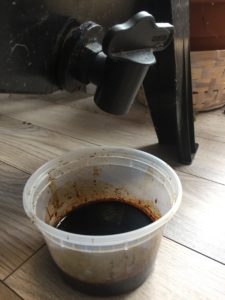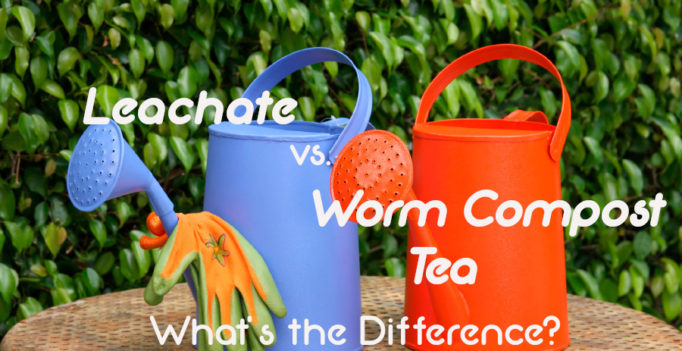Just a couple months ago, we featured an article on the wonders and uses of worm compost tea. Since then, we’ve received tons of emails asking to hear more about worm tea’s cousin, leachate, and how it differs from the tea. So, today, we’ll clear up any lingering questions about those differences and learn why none of it needs ever go to waste.
Wikipedia defines leachate as, “… any liquid that, in the course of passing through matter, extracts soluble or suspended solids, or any other component of the material through which it has passed.”
So, what is the difference between leachate and “worm tea?” Among other things, one seeps, while the other steeps.
Same, Same, Different
As they come from the same initial source and have something to do with water, it seems they should be fairly similar, right? So, what is it that makes one so highly esteemed above the other?
A worm compost tea is a beloved brew known to boost microbiological activity in soil by adding bacteria, fungi, actinomycetes, and protozoa to the ecosystem of our soils. In other words, it’s an excellent fertilizer treatment. Created (man-made) using a large volume of water, it’s specifically the oxygen-loving bacteria that work to support the life of healthy root systems. Consistent use of worm compost tea serves to bring balance to natural areas.
On the other hand, leachate is derived from the naturally occurring process of micro amounts of moisture leaching through a worm bin. As it goes along, it picks up all sorts of bacterial hitchhikers. At times it may sit stagnant, which means some of the bacteria prevalent in leachate are the anaerobic type- which won’t add the life we’re looking to restore in our soils but does still offer organic matter and nutrients.
Where Does Leachate Come From?
In a worm bin, the liquid that exists is usually a combination of moisture from humidity in the air, decomposing fruits and vegetable matter, along with any water you may add to the bedding. Gravity simply draws this moisture into the bedding, through the worm compost, and down to either a catch basin or through drainage holes to whatever lies beneath. What drips out is the leachate.
What Does it Look Like?
As you can imagine, the finely processed, and organic richness of the compost itself means that the moisture leached from it will also be similarly dark and nutrient dense. What I see dripping from the tap or my Worm Factory 360 comes out dark like molasses but not nearly as thick. Worm compost tea, by contrast, is not nearly as dark and can be seen through, to some extent.
Is it Trash or Treasure?
As it turns out, after learning what to do with worm compost tea, worm farmers around the world now want to know, “Well then, what can I do with this leachate?” We don’t like to waste a thing around here, and being industrious is a virtue, so let’s see if there’s anything it’s good for.
Leachate can stain; leachate can smell; leachate may contain phytotoxins that are harmful to plants and humans. In fact, I consider it somewhat like toxic sludge. (I know how slimy gross some of the food I can put in there starts out as… I wouldn’t go swimming in it and don’t want my kids to stick their fingers in it either.)
The uses of leachate are pretty limited to the benefits one would expect of such a thing. It is simply a liquid nutrient meant for invigorating soils and plant life. So, as you will see below, I collect mine.
Use it or Lose it

Through the winter, I use the leachate I catch to create a dilute solution for watering indoor plants. If it smells, I don’t use it. Because then I’d have to smell it whenever I’d walk by, and yuck. But if it doesn’t smell, I consider adding diluted leachate a pretty good way to bolster regular waterings of things grown indoors that I won’t be consuming.
If it does stink- that means there are anaerobic bacteria, perhaps pathogens, at work in there. But poured back into the worm bin, that leachate will get absorbed into the bedding, eventually digested by the worms, and made into perfectly usable high-quality compost. Not a thing needs to go to waste!
My favorite use of leachate comes directly from one of our generous readers who shared her own brilliant way of putting hers to use. She collects it in a hose attachment and waters the lawn with it- thereby quickly and easily aerating it, diluting it, and distributing it widely. Isn’t that smart?
Tea/Leachate Hybrid
When the growing season is on, and my worms are outside, I often find myself wanting to give some extra nourishing drinks of water to my flowering trees and shrubs. It’s then that I’ll open the top of my Worm Factory 360 and slowly pour about a gallon of grey water right over it- like a pour over coffee. I catch everything at the bottom and then have a super-concentrated fertilizer to work with right away. I add more grey water to stretch it and consider it a hybrid.
Technically, this pour over method does create precisely a leachate, but because of the volume of water I use and then dilute with,…I’ll call it a “teachate”! This is something I can use throughout much of my landscape, but not where I grow food crops (in case of pathogens in any of the organic matter the worms did not process.)
Final Notes
When making the most of your leachate, follow these common-sense guidelines to protect yourself and your plants from harm.
1. DON’T use it to feed plants if it smells bad! Pour it back into the worm bin or flush it.
2. Dilute it to at least 10:1, water to leachate.
3. If you can, brew it in a bucket with an aerator before application.
4. Only use it outdoors on shrubs, ornamentals or flowering plants. NOT on edibles.
Now that you know the difference between leachate and worm tea, you can make the most of each of them! To learn more about the finer points of worm composting, sign up for The Squirm Firm’s free monthly newsletter. Just once each month we’ll deliver the latest edition full of tips, tricks, and expert advice to your inbox.
Happy worm composting!


Very good explanation of the 2. I agree with your reasoning have never had leachate in my work bins ever. All it takes is to keep an eye on your bin,very simple and easy to do.